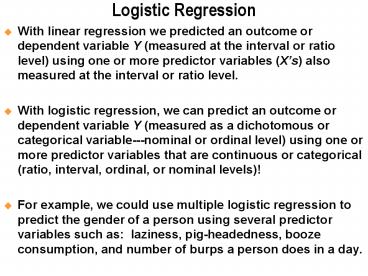Logistic Regression PowerPoint PPT Presentation
1 / 8
Title: Logistic Regression
1
Logistic Regression
- With linear regression we predicted an outcome or
dependent variable Y (measured at the interval or
ratio level) using one or more predictor
variables (Xs) also measured at the interval or
ratio level. - With logistic regression, we can predict an
outcome or dependent variable Y (measured as a
dichotomous or categorical variable---nominal or
ordinal level) using one or more predictor
variables that are continuous or categorical
(ratio, interval, ordinal, or nominal levels)! - For example, we could use multiple logistic
regression to predict the gender of a person
using several predictor variables such as
laziness, pig-headedness, booze consumption, and
number of burps a person does in a day.
2
Logistic Regression 2
- On a serious note, logistic regression is used in
medical research to formulate models about
variables that predict whether a tumor is likely
to be cancerous or benign, what variables predict
whether a heart attack or stroke survivor is
likely to have a subsequent heart attack or
stroke. - In social science, logistic regression has been
used to develop models that predict the odds that
convicts will recidivate or not which variables
predict if couples will get divorced or not
what variables predict whether people will vote
for a certain party or not what variables
predict if a consumer will purchase a product or
not, etc., etc., etc.
3
Principles behind Logistic Regression
- In linear regression, we predict Y using a
combination of each predictor variable multiplied
by its respective regression coefficient as
illustrated in the formula - With logistic regression, instead of predicting
the value of Y from one or more predictors, we
predict the probability of Y occurring given
certain values of the predictor variables using
the following formula...
Y a b1X1 b2X2 . bnXn e
4
(No Transcript)
5
(No Transcript)
6
Principles of Logistic Regression 2
- Despite similarities in the underlying equations,
we cannot apply linear regression directly to a
situation where the outcome variable is
dichotomous. - One of the assumptions of linear regression is
that the relationship between the variables is
linear. When the outcome variable is dichotomous
this assumption is not tenable. - One way to circumvent this problem is to
transform the data using the logarithmic
transformationa modification of the data which
as the effect of expressing a non-linear
relationship between variables in a linear way.
7
Principles of Logistic Regression 3
- Logistic regression expresses the multiple linear
regression equation in logarithmic terms and
resolves the violation of the linearity
assumption. - The resulting value from the equation is a
probability that varies from 0 to 1. A value
close to 0 means that Y is very unlikely and a
value close to 1 means that Y is very likely. . - Each predictor variable in logistic regression
has its own coefficient. The logistic regression
coefficients are estimated using the
maximum-likliihood methodwhich selects
coefficients that make the observed data values
most likely to have occurred. This is the way
that SPSS optimizes the fit of the logistic
regression model.
8
Logistic Regression A Research Example
- A researcher interested in childhood
socialization wants to identify variables that
predict a childs understanding of social display
norms or rules (an understanding of how to behave
in social situations among children). - The researcher suspects that the childs age and
empathy skills (ability to appreciated the
thoughts and feelings of others), are important
predictors of the childs ability to follow
social display norms. - The outcome variable (Y) is the childs
possession of social display norms (Did the child
pass the social display norm test Yes/No?).
The first predictor variable (X1) is the
possession of empathy (Did the child pass the
empathy test Yes/No?). The second predictor
variable (X2) is the childs age in month (a
continuousinterval or ratio..variable).

